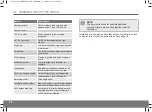
07 DESCRIPTION OF THE TRUCK
22
Premises and requirements
A measurement can only be taken when the forks have been
lowered and stopped between the transport position switch and
floor level. The forks must be stationary for approx. 2 seconds.
It is important that the entire load is borne by the forks and does
not, for example, rest on the floor or other objects – otherwise
the reading will be incorrect.
For best accuracy, the forks must be stopped quickly after
lowering, at a relatively rapid speed. Ensure that the load is
secure on the forks when doing this.
The minimum load weight is 100 kg.
NOTE!
The result of the weight measurement during lifting
can be affected if the oil temperature of the truck is
different from the oil temperature during weight
calibration.
Accuracy, weight indication
The system's weight indication has a nominal accuracy of +/- 50
kg. The measurement reading can however differ more than
this if the forks are lowered slowly.
Functions
The weight indicator system is comprised of a number of
functions. For specification and use of the various functions,
see
Weight indication
page 42
Dynamic Curve Control (DCC)
Dynamic Curve Control (DCC) is an electronic auxiliary system
which reduces the risk of tipping accidents. When the driver
increases speed too quickly, or is driving too fast, in
combination with sharp turns, the system compensates by
reducing the speed and acceleration.
Trucks which are equipped with S3 (see
Stability Support
System, S3-1
page 20) have Dynamic Curve Control built in.
Active Spin Reduction, ASR (option)
If the truck drive wheel slips on the floor surface a warning lamp
flashes in the middle of the display and the speed is reduced to
a crawl. After 2 seconds, if grip is regained, the truck gradually
accelerates to normal speed.
NOTE!
ASR does not operate in the case of a four-way truck
travelling sideways.
Instruction Handbook UFW — D008453, B, GBR, ForTranslation




































